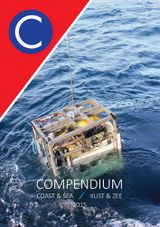|
|
| (17 intermediate revisions by the same user not shown) |
| Line 1: |
Line 1: |
| − | '''Gravel Beaches'''
| + | <div style="float:right; margin-left:10px; margin-top:5px">[[File:Compendiumcoastandsea.jpg|160px|right|link=Compendium for Coast and Sea - creating a marine science-policy interface]]</div> |
| − | | + | '''Compendium for Coast and Sea - creating a marine science-policy interface''' |
| − | [[Image:Sediment supply from soft cliffs.jpg|thumb|right|250px|Sediment supply from soft cliffs <br> © A. J. Chadwick]] | + | <p style="margin-top:-15px"><br/></p> |
| − | | + | The Compendium for Coast and Sea is an integrated knowledge document about the socio-economic, environmental and institutional aspects of the coast and sea in Flanders and Belgium. As such, it constitutes a one-stop shop for data and information from the Flemish and Belgian marine and maritime research community and experts. The Compendium for Coast and Sea is an initiative of the Flanders Marine Institute (VLIZ) and was developed in close collaboration with experts from the research community, government, industry and civil society organisations. The first version of the Compendium was launched in 2013, a second edition was presented in 2015. |
| − | Gravel beaches are widespread around the world, including the USA, Canada, Japan, Argentina, New Zealand and the wave dominated coastlines of Northern Europe <ref name="Buscome 2006">Buscome D., Masselink G. (2006). Concepts in gravel beach dynamics. Earth science Reviews 79 33-52.</ref>. In the UK, about one third of the coastline is protected by such beaches <ref name ="Fuller 1988">Fuller, R. M. & Randall, R. E. (1988). The Orford Shingles, Suffolk, UK. Classic conflicts in coastline management. Biological conservation. </ref>.
| + | </div> |
| − | <p> | |
| − | In coastal defence schemes, considerable use is made of coarse-grained (gravel) sediment to replenish [[Coast erosion|eroding beaches]], often in conjunction with structures such as rock or wooden [[groynes]] or offshore breakwaters. This is because such beaches are known to be an efficient form of natural coastal defence <ref name="powel 1990">Powell, K. A. (1990). Predicting short term profile response for shingle beaches. HR Wallingford Report SR 219. </ref><ref name ="Diserens">Diserens, A. P. & Coates, T. T. (1993). UK South Coast shingle beach study: storm response of shingle beaches. HR Wallingford Report SR 323.</ref>. Two examples from the UK are those at Sidmouth, Devon and Elmer, West Sussex.
| |
| − | <p>
| |
| − | Research into the particular characteristics of gravel beaches and their engineering analysis is relatively new, with much of the progress being made recently. In the 1990’s small scale experimental measurements and early field studies lead to the subsequent development of parametric models for profile prediction, longshore transport and the stability of [[Barrier beach|barrier beaches]]. Since 2002, two major large scale experimental studies and some new comprehensive field studies have been undertaken. Since that time, good progress has also been made in process based numerical modelling systems for long and cross shore transport.
| |
| − | <p>
| |
| − | The emphasis of the article is to present in a clear and concise manner the most relevant concepts, basic understanding and insights into the behaviour of gravel beaches, to provide a summary of the available engineering analysis techniques and modelling approaches and to provide guidance to further reading and a list of the most relevant references to work carried out since 1990... | |
Compendium for Coast and Sea - creating a marine science-policy interface
The Compendium for Coast and Sea is an integrated knowledge document about the socio-economic, environmental and institutional aspects of the coast and sea in Flanders and Belgium. As such, it constitutes a one-stop shop for data and information from the Flemish and Belgian marine and maritime research community and experts. The Compendium for Coast and Sea is an initiative of the Flanders Marine Institute (VLIZ) and was developed in close collaboration with experts from the research community, government, industry and civil society organisations. The first version of the Compendium was launched in 2013, a second edition was presented in 2015.
